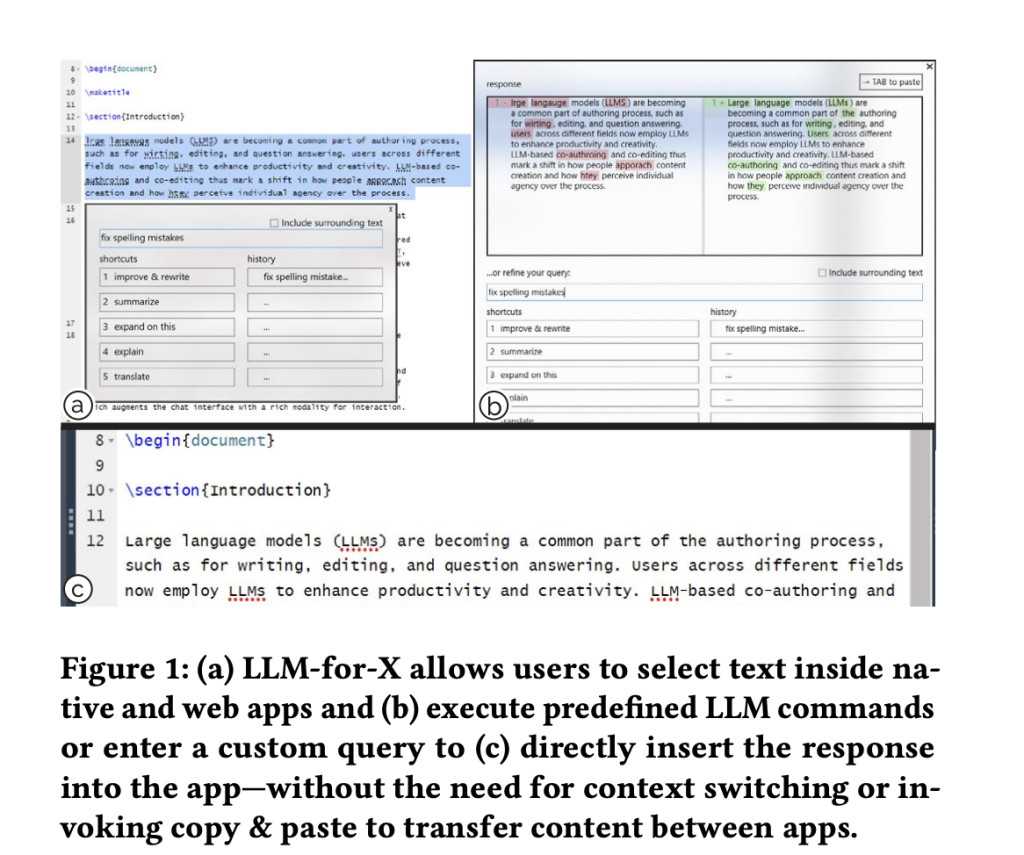Integrating advanced language models into writing and editing workflows has become increasingly important in various fields. Large language models (LLMs) such as ChatGPT and Gemini transform how individuals generate text, edit documents, and retrieve information. These models enable users to improve productivity and creativity by seamlessly integrating powerful language processing capabilities into their daily tasks.
Researchers have identified a significant problem: the inefficiency and fragmentation of using LLMs across multiple applications. Users often need to copy and paste text between different platforms to utilize these models, which disrupts their workflow and decreases productivity. This fragmentation is due to the lack of a unified interface that integrates LLM capabilities within the native environment of various applications. The need for a more cohesive and efficient approach has driven recent innovations in this field.
Existing methods to incorporate LLM functionality primarily involve browser-based interfaces or specialized applications like Grammarly and Microsoft Office’s Copilot. While these solutions offer valuable assistance, they require users to navigate between different windows or subscribe to multiple services, each providing overlapping capabilities. This fragmentation leads to inefficiencies & higher costs for users. For instance, subscribing to numerous LLM-based services can become expensive, and the necessity to switch contexts frequently hampers the overall user experience.
Researchers from ETH Zürich introduced LLM-for-X, a system designed to integrate LLM services directly into any application via a lightweight popup dialog. This innovative method allows users to access LLM functionalities without switching contexts or copying and pasting text. The system supports popular LLM backends such as ChatGPT and Gemini, ensuring broad applicability across different platforms. LLM-for-X enhances user productivity and streamlines the writing and editing process by eliminating the need for multiple subscriptions and reducing the time spent switching between applications.
The technology behind LLM-for-X involves a system-wide shortcut layer that connects front-end applications to LLM backends. When activated, users can select text within any application input commands and receive LLM-generated responses directly in the same interface. This seamless integration is achieved through keyboard shortcuts and a lightweight on-demand popup UI. For example, a user can select text in Overleaf, trigger LLM-for-X via a keyboard shortcut (e.g., Alt + 1), and receive suggestions or corrections without leaving the application. This method significantly reduces the need for context switching and improves the overall efficiency of the writing process.
The performance of LLM-for-X was evaluated through a series of user studies involving 14 participants from various departments. These participants, aged 22-37 years, had prior experience with Python and frequently used LLM-based tools like ChatGPT and Copilot. The study compared participants’ performance in completing writing, reading, and coding tasks using LLM-for-X and ChatGPT’s web interface. Participants were significantly faster in completing editing tasks using LLM-for-X, with an average completion time of 31.71 seconds compared to 51.14 seconds for ChatGPT. The usability scores were also higher for LLM-for-X, with a System Usability Scale (SUS) score of 62.54 compared to 51.68 for ChatGPT.
In the user study, participants completed tasks that included summarizing paragraphs, editing narratives, and composing emails. For summarizing, participants worked on an academic paper draft in Overleaf; for editing, they rewrote a narrative paragraph in Microsoft Word; and for composing, they drafted emails in Microsoft Outlook. They completed a reading task involving a folk story from a foreign language and a coding task using Python in VSCode. These tasks were designed to analyze the efficacy of LLM-for-X in various real-world scenarios.
The study’s results highlighted several advantages of LLM-for-X. Participants reported feeling more efficient when using the tool because it eliminated the need for context switching. For example, P1 noted that “LLM-for-X is more integrated into the environment,†reducing the need to shift focus compared to ChatGPT. The shortcuts for menu initiation and text insertion were also appreciated, with P7 commenting, “No copy-paste is required when using the tool.†However, some participants preferred the personalization and user-friendliness of the ChatGPT interface, indicating areas for future improvement.
In conclusion, LLM-for-X addresses the inefficiencies and fragmentation in integrating LLM functionalities across different applications. A unified, context-aware interface enhances productivity and user experience, making advanced language model capabilities more accessible and practical for everyday use. This innovation represents a significant advancement in applying LLMs in personal and professional writing workflows. By enabling seamless integration of LLM services, LLM-for-X allows users to leverage the potential of these models without the disruptions associated with traditional methods.
Check out the Paper. All credit for this research goes to the researchers of this project. Also, don’t forget to follow us on Twitter and join our Telegram Channel and LinkedIn Group. If you like our work, you will love our newsletter..
Don’t Forget to join our 47k+ ML SubReddit
Find Upcoming AI Webinars here
The post LLM-for-X: Transforming Efficiency and Integration of Large Language Models Across Diverse Applications with Seamless Workflow Enhancements appeared first on MarkTechPost.
Source: Read MoreÂ


